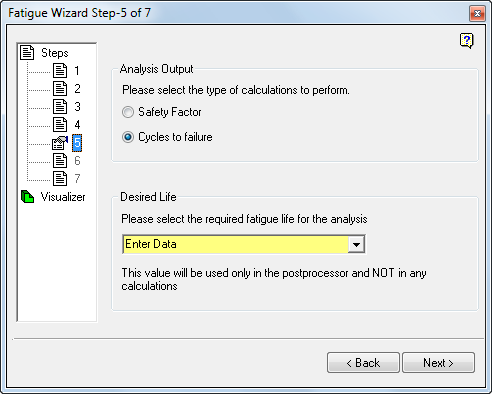The layout of the Step 5 dialog box depends upon whether you elected to perform a fatigue life calculation or a fatigue safety factor calculation in Step 1. Fatigue Wizard tailors the form presented at Step 5 accordingly, and different input is required.

Case 1: When Strain or Stress Based Fatigue Life analysis is specified in Step 1
When either the Strain Based Life (EN) or Stress Based Life (SN) analysis option is specified in Step 1, the Analysis Output section of Step 5 presents two additional calculation options. Specify which type of calculation you want to perform—Safety Factor or Cycles to failure.
The Cycles to failure option outputs just what the name implies, how many cycles of the specified load curves the model will survive before fatigue failure.
In the Desired Life input field, specify the number of cycles of fatigue life desired. You can select a number from the provided drop-down menu (in powers of 10 from one to ten million cycles) or type in another number. The usage of this inputs depends upon the selection made in the Analysis Output section of Step 5:
| Specified Analysis Output option | How the Desired Life value is used |
|---|---|
| Safety Factor | The safety factor calculation is based on the desired number of life cycles. |
| Cycles to failure | The desired number of life cycles is used only for post-processing and does not affect the calculation. |
Currently, you cannot control which load cases are scaled within a Safety Factor calculation. Fatigue Wizard applies the same stress scaling to all nodes and all load cases that are active in the fatigue calculation.
Case 2: When a Fatigue Safety Factor analysis is specified in Step 1
When a Fatigue Safety Factor analysis is specified in Step 1, the choices in the Step 5 Analysis Output section are grayed-out.
Type in the desired fatigue safety factor in the Desired Life input field (for example, 1.25 or 1.5). This value is used only for post-processing and does not affect the calculations. Fatigue Wizard classifies the results as acceptable, marginal, or unacceptable based on a comparison of the calculated safety factor to the desired safety factor.